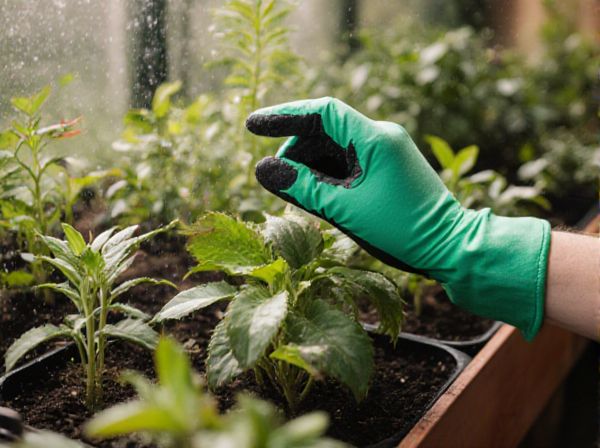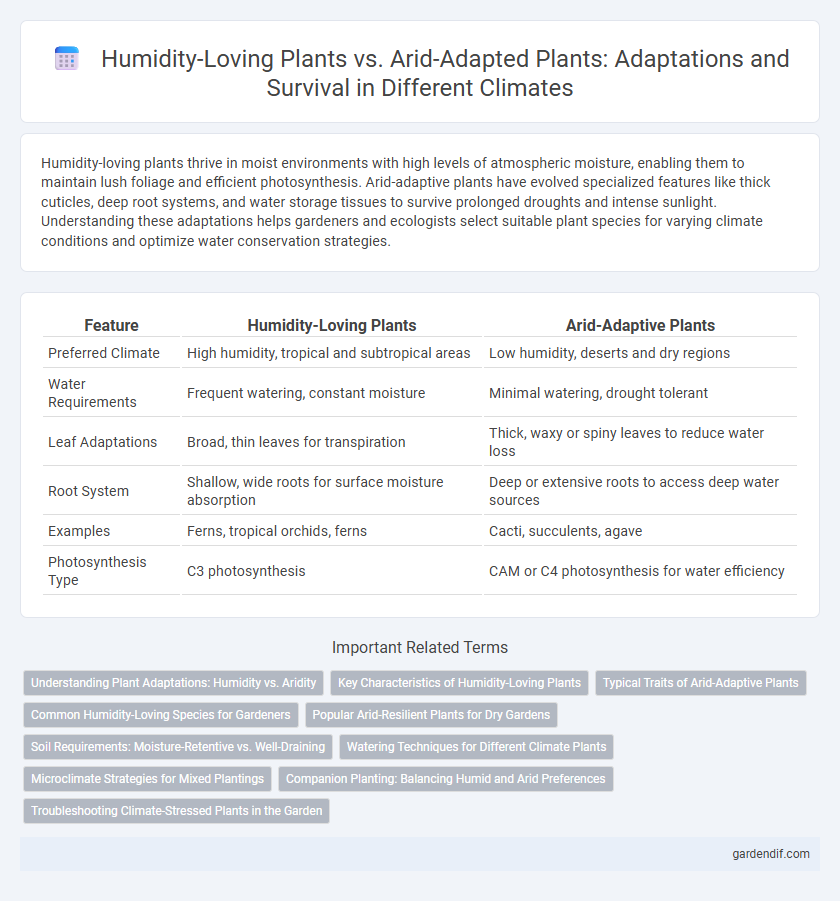
Humidity-Loving Plants vs Arid-Adaptive Plants Illustration
Humidity-loving plants thrive in moist environments with high levels of atmospheric moisture, enabling them to maintain lush foliage and efficient photosynthesis. Arid-adaptive plants have evolved specialized features like thick cuticles, deep root systems, and water storage tissues to survive prolonged droughts and intense sunlight. Understanding these adaptations helps gardeners and ecologists select suitable plant species for varying climate conditions and optimize water conservation strategies.
Table of Comparison
| Feature | Humidity-Loving Plants | Arid-Adaptive Plants |
|---|---|---|
| Preferred Climate | High humidity, tropical and subtropical areas | Low humidity, deserts and dry regions |
| Water Requirements | Frequent watering, constant moisture | Minimal watering, drought tolerant |
| Leaf Adaptations | Broad, thin leaves for transpiration | Thick, waxy or spiny leaves to reduce water loss |
| Root System | Shallow, wide roots for surface moisture absorption | Deep or extensive roots to access deep water sources |
| Examples | Ferns, tropical orchids, ferns | Cacti, succulents, agave |
| Photosynthesis Type | C3 photosynthesis | CAM or C4 photosynthesis for water efficiency |
Understanding Plant Adaptations: Humidity vs. Aridity
Humidity-loving plants thrive in environments with consistently high moisture levels, featuring adaptations such as large, broad leaves to maximize transpiration and thin cuticles to facilitate gas exchange. Arid-adaptive plants, like succulents and cacti, possess thick, waxy cuticles, reduced leaf surfaces, and deep root systems to minimize water loss and maximize water uptake. These contrasting adaptations exemplify how plant morphology and physiology are finely tuned to optimize survival in either humid or dry climates.
Key Characteristics of Humidity-Loving Plants
Humidity-loving plants thrive in environments with consistently high moisture levels, typically above 60% relative humidity, enabling lush foliage and rapid growth. These plants often exhibit large, broad leaves with thin cuticles to maximize transpiration and nutrient absorption from the air. Common examples include ferns, orchids, and tropical rainforest species, which rely on ambient humidity for photosynthesis and reproduction cycles.
Typical Traits of Arid-Adaptive Plants
Arid-adaptive plants exhibit specialized traits such as thick, waxy cuticles that minimize water loss and deep root systems designed to access scarce groundwater. Their small, reduced leaves or spines reduce surface area, limiting transpiration under intense sunlight. These plants often employ CAM photosynthesis, optimizing water use efficiency in extreme dry climates.
Common Humidity-Loving Species for Gardeners
Common humidity-loving plant species for gardeners include ferns, peace lilies, and calatheas, which thrive in moist environments with consistent humidity levels above 60%. These plants have adapted to absorb moisture efficiently through their leaves and require shaded or partially shaded conditions to prevent dehydration. Maintaining high humidity in indoor or greenhouse settings promotes vibrant foliage and reduces stress-related issues like leaf browning and wilting.
Popular Arid-Resilient Plants for Dry Gardens
Popular arid-resilient plants for dry gardens include succulents like agave, aloe vera, and cacti, which thrive with minimal water by storing moisture in their thick leaves. Other well-adapted species such as lavender, sage, and yucca withstand intense sunlight and poor soil conditions while requiring limited irrigation. These drought-tolerant plants enhance xeriscaping efforts, promoting sustainable landscaping in arid climates by conserving water resources.
Soil Requirements: Moisture-Retentive vs. Well-Draining
Humidity-loving plants thrive in soil that is moisture-retentive, often rich in organic matter to maintain consistent dampness essential for their growth. In contrast, arid-adaptive plants require well-draining soil with sandy or gritty textures to prevent water accumulation and root rot, supporting their survival in dry conditions. Proper soil composition directly influences water availability and aeration, critical factors distinguishing the cultivation of these two plant types.
Watering Techniques for Different Climate Plants
Humidity-loving plants thrive with consistent moisture levels, requiring frequent, light watering to maintain damp soil without waterlogging roots. Arid-adaptive plants, such as succulents and cacti, benefit from infrequent but deep watering to encourage extensive root systems and prevent rot in dry environments. Tailoring watering techniques to plant adaptations ensures optimal health and growth by mimicking natural moisture availability in different climates.
Microclimate Strategies for Mixed Plantings
Humidity-loving plants thrive in environments with consistent moisture and high atmospheric humidity, often benefiting from shaded or sheltered microclimates that reduce water loss. Arid-adaptive plants excel in dry, low-humidity conditions by employing strategies such as deep root systems, waxy leaf coatings, and reduced leaf surface area to minimize transpiration. Creating mixed plantings involves strategically positioning humidity-loving species in microhabitats that retain moisture, such as shaded areas or near water sources, while placing arid-adaptive plants in zones with maximum sun exposure and well-drained soil to optimize overall water use efficiency and plant health.
Companion Planting: Balancing Humid and Arid Preferences
Companion planting that balances humidity-loving plants like ferns and calatheas with arid-adaptive species such as succulents and cacti enhances microclimate regulation and soil moisture retention. Integrating these diverse plants requires strategic spacing and selective watering techniques to prevent overhydration or drought stress. This approach optimizes growth conditions, promotes biodiversity, and reduces pest infestations by leveraging the complementary environmental adaptations of each plant type.
Troubleshooting Climate-Stressed Plants in the Garden
Humidity-loving plants, such as ferns and peace lilies, require consistent moisture levels and may exhibit leaf browning or wilting when exposed to dry, arid conditions. In contrast, arid-adaptive plants like succulents and cacti thrive in low humidity and can suffer from root rot or fungal infections if overwatered in humid environments. Proper identification of a plant's climate preference, combined with adjusting watering schedules and humidity levels, is essential to troubleshoot and restore the health of climate-stressed garden plants.
Humidity-Loving Plants vs Arid-Adaptive Plants Infographic

 gardendif.com
gardendif.com